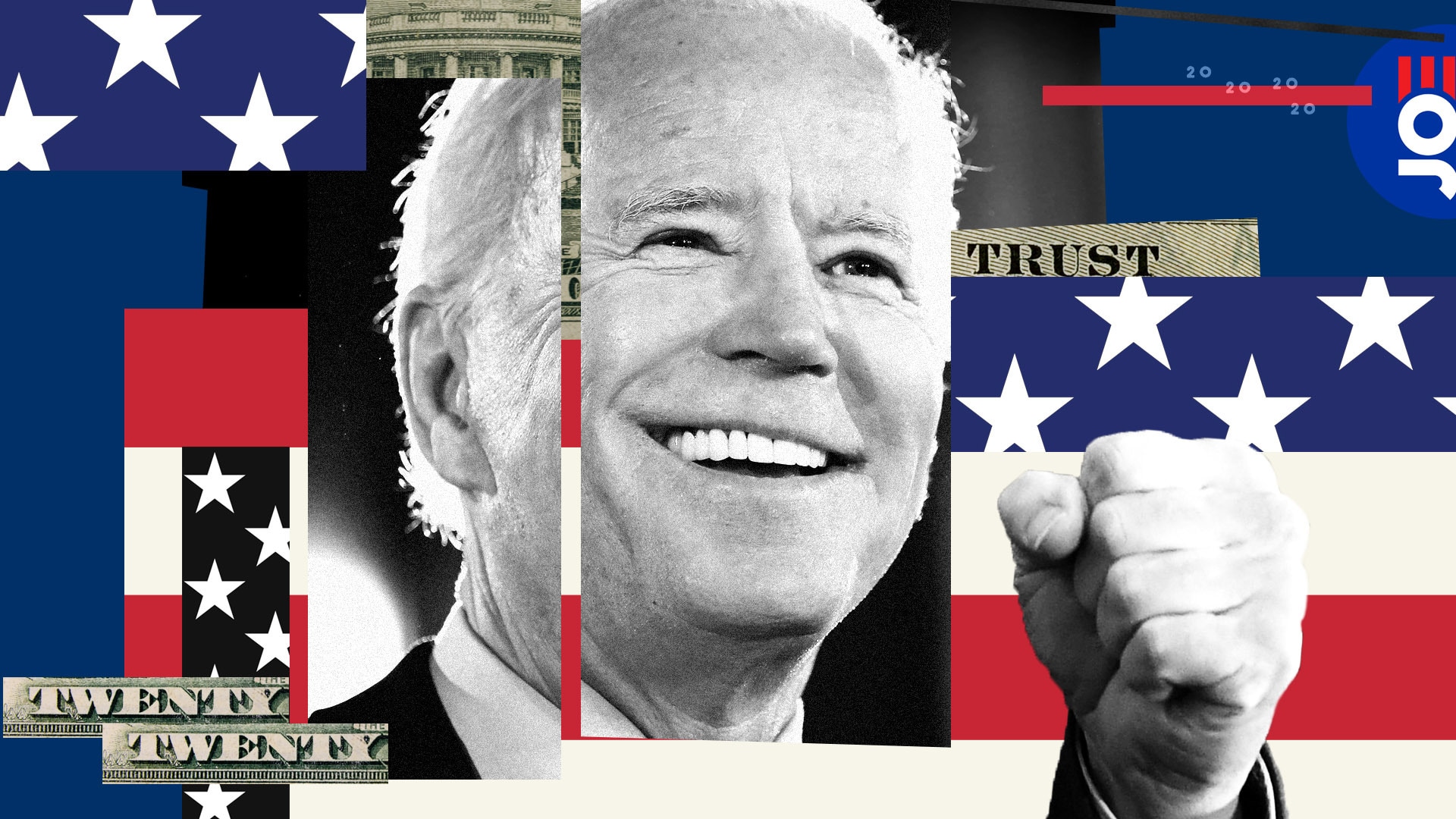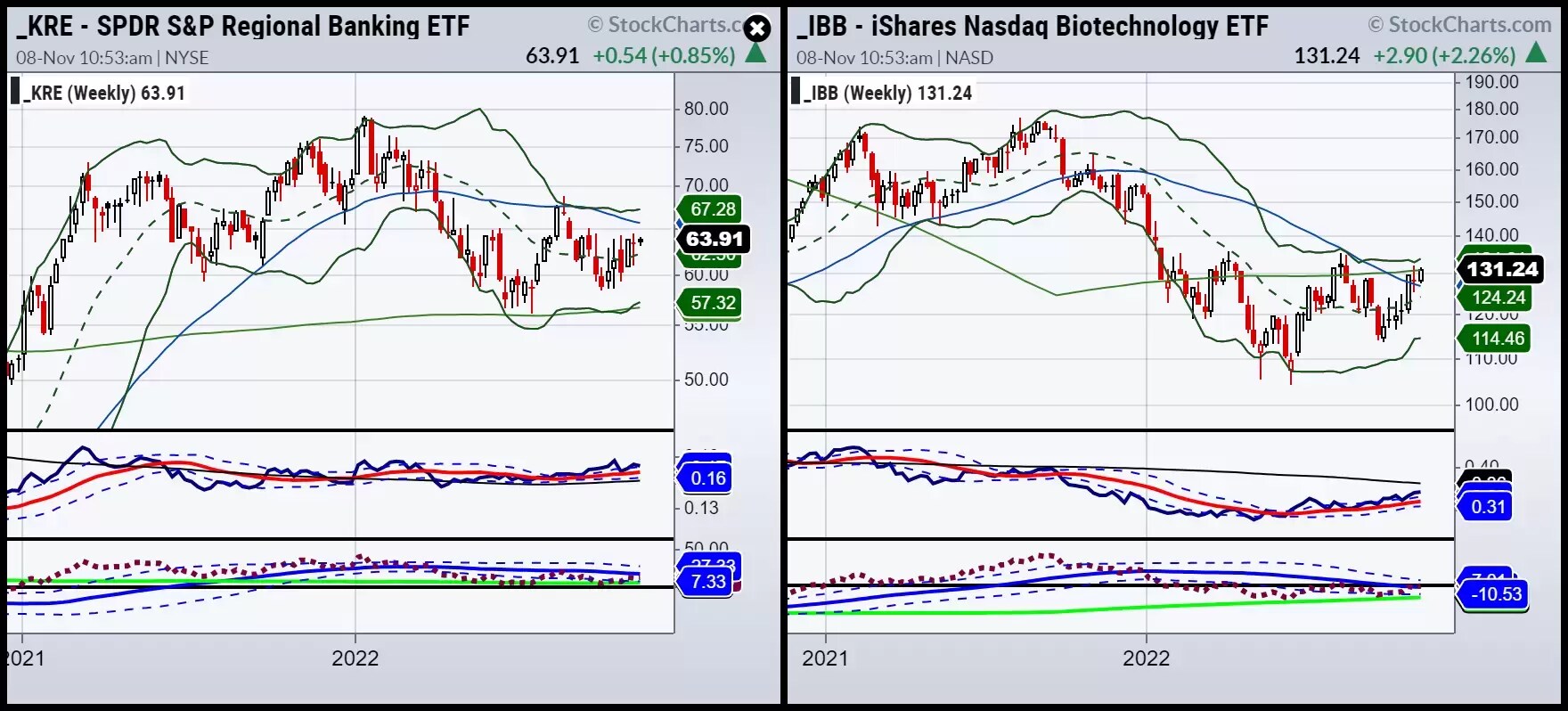
Now that the US has made it through the day of voting for some 435 seats in the House of Representatives and 35 in the Senate, the final counts begin.
This year's midterm elections may be more about the economic hardship being felt and which party voters believe is to blame, or has the most potential to change their economic fortunes.
This is the perfect time to ask our ‘economic modern family’ who they voted for. And more importantly, what each one of them is telling us about our near-term market investing.

Beginning with grandad Russell 2000 and grandma retail, the weekly charts are compelling.
The ishares Russell 2000 ETF [IWM] has submitted a vote of confidence by way of its price recapture over the 200 weekly moving average (WMA, green line). However, the index appears to be saving some enthusiasm, as this week’s price action is trading within the range of last week’s price action.
The middle chart, or the leadership versus the benchmark, shows IWM outperforming, as small caps have been doing for a while now. The bottom chart, or the real motion indicator, shows momentum on a weekly basis is middling to weak.
If we use the range of last week (high of $185.60; low at $174.11), then a very simple post-election formula is to think bullish on a weekly close above last week’s high. Conversely, think bearish on a weekly close below last week’s low.
Grandma retail is not as strong. She appears to be tagging along for the ride more than leading. For a sustained rally, the consumer (who is probably going further into debt) must hang in there. The SPDR S&P Retail ETF [XRT] is also having an ‘inside week’. Furthermore, the price sits just at the 200-WMA, which is an area that must hold and clear.

If grandad and grandma are leading in economic optimism, then our favourite grandson, the iShares Transportation Average [IYT], must show that the demand side verifies that optimism.
IYT is actually doing a bit better than the XRT, above its 200-WMA, and must stay there (at around $215). The momentum however, like the whole family, remains lacklustre. So far, the takeaway is muted bullishness with a tad of scepticism.
It’s the same for our sister, the VanEck Vectors Semiconductor ETF [SMH]. With yields softening and the US dollar falling, SMH has handily cleared her 200-WMA. Again though, momentum is not convincing. Additionally, note that both IYT and SMH are underperforming the benchmark.

Less discussed but extremely important to the overall health of the family are these two sectors: banking and biotechnology. Incidentally, the best time to load up long or short is when the whole family trades in the same direction.
The SPDR S&P Regional Banking ETF [KRE] hasn’t broken below its 200-WMA at all this year, which makes total sense as the interest rates are higher. Nonetheless, KRE has hardly wowed. Though another ‘inside week’ is forming in price, this sector, as one of the top two best performers in the whole family, merits a watch. Skyrocketing mortgage rates are the reason that KRE has not performed even better. Any softening on yields, and we could see our ‘prodigal son’ move up to test the $67 price range.
Biotechnology is the other sector to watch very closely. After the iShares Nasdaq Biotechnology ETF [IBB] bottomed out in June, it’s made a series of higher lows. IBB well outperforms the benchmark, and the momentum, although lagging market leaders, is doing better than its relatives. A weekly close over 133 will be the highest weekly close of 2022.

Disconcerting at best, our newest member of the economic modern family, cryptocurrency, represented by Bitcoin [BTCUSD], is having a slew of issues this week. Between the rumours of the FTX token being bought by Binance, and the political footballing on how to regulate cryptocurrencies amid the many special interest groups and money at stake, BTC looks rather pessimistic.
If the price action moves below 18,000, we could see a domino effect not only in other cryptocurrencies, but also in equities.
The modern family perfectly represents the tone of investors right now. If the Republicans manage to sweep up in the midterms, it could give the family a boost. On the other hand, regardless of the outcome, the whole sentiment of the country is one of basic distrust for governments and central banks. Inflation is the top concern.
Grandma retail (XRT) will tell you about inflation concerns, as will transportation (IYT). The biotechnology and regional banking ETFs may not care as much. Ultimately, the Federal Reserve’s policy will have its say at December’s meeting.
Watch out for sector rotation and harmony versus disharmony. Either way, this family of ETFs is likely to forecast the market’s next moves.
Mish’s ETF support and resistance levels
S&P 500 [SPY] Inside 375 near-term support, with 390 resistance
Russell 2000 [IWM] Watch the range 185.60 to 174.11
Dow [DIA] Must close the week over 330, or will be a failure
Nasdaq [QQQ] Either this clears 276, or we see another stab at 260
Regional Banking [KRE] 65.00 resistance; 60.00 support
Semiconductors [SMH] Popped over the 50-DMA; 190 key support; 204 resistance
Transportation [IYT] 215 key pivotal area for the week; a fall under 210 would not positive
Biotechnology [IBB] 132 resistance; 127 nearest support
Retail [XRT] Must close over 62.00, and hold 59.00
Mish Schneider is MarketGauge’s director of trading education and research. Read more of MarketGauge’s market analysis here, and subscribe to their YouTube channel here. Mish Schneider's and MarketGauge's views and findings are their own, and should not be relied upon as the basis of a trading or investment decision. Pricing is indicative. Past performance is not a reliable indicator of future results.
Disclaimer: CMC Markets is an execution-only service provider. The material (whether or not it states any opinions) is for general information purposes only, and does not take into account your personal circumstances or objectives. Nothing in this material is (or should be considered to be) financial, investment or other advice on which reliance should be placed. No opinion given in the material constitutes a recommendation by CMC Markets or the author that any particular investment, security, transaction or investment strategy is suitable for any specific person. The material has not been prepared in accordance with legal requirements designed to promote the independence of investment research. Although we are not specifically prevented from dealing before providing this material, we do not seek to take advantage of the material prior to its dissemination.























